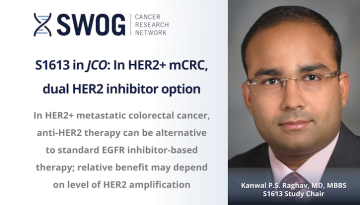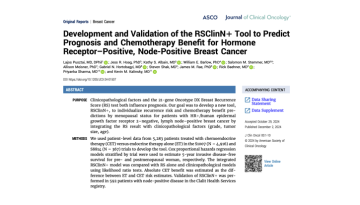A Banner Year for SWOG in San Antonio
When it comes to SWOG’s presence at this year’s San Antonio Breast Cancer Symposium (SABCS), we really do have a December to remember, with ten SWOG abstracts presented, including one that the SABCS planners featured in their own press conference on Tuesday. Our landmark S1007 RxPONDER trial – in women with HR+, HER2- breast cancer with one to three involved lymph nodes and a recurrence score (RS) of 25 or less – was again the source of several abstracts. Here are some of the research result highlights of a very busy week in San Antonio!
- With race and/or ethnicity information available for more than 81 percent of RxPONDER patients, SWOG researchers analyzed clinical outcomes associated with these factors. They found five-year invasive disease-free survival (IDFS), the trial’s primary endpoint, was statistically significantly lower for non-Hispanic Blacks than for Asians, non-Hispanic Whites, or Hispanics. These results were independent of RS, treatment arm, patient age, and disease grade, although the limited number of patients in the non-Hispanic Black cohort meant that definitive conclusions can’t be drawn about racial differences in treatment benefit. Yara Abdou, MD, of University of North Carolina, delivered the results at an SABCS-sponsored press conference on Tuesday.
- Researchers led by Irene M. Kang, MD, of City of Hope, compared patient-reported cognitive impairment over time across RxPONDER’s two arms and by patient menopausal status. They found that, on average, patients on both arms tended to suffer cognitive impairment at the 6-month and 12-month marks during treatment. However, by 36 months, patients on the endocrine therapy-only arm had recovered baseline cognitive function, while for those who received both endocrine therapy and chemotherapy, mean scores remained below baseline levels at 36 months.
- Laura Spring, MD, of Dana Farber/Harvard Cancer Center, led a group that evaluated the effect of HER2-low status on RxPONDER patient outcomes across treatments and by menopausal status. They found no statistical imbalance between HER2-low status and treatment group (chemo-endocrine therapy versus endocrine therapy alone). Among premenopausal women, 52 percent had HER2-low breast cancer, while the rate was 57 percent among postmenopausal women.
- Mariana Chavez Mac Gregor, MD, MSc, SWOG executive officer for international affairs, reported results of the S1207 trial, which tested adding one year of everolimus to adjuvant endocrine therapy after chemotherapy in patients with HR+, HER2- breast cancer. Across all patients, everolimus did not lengthen IDFS or overall survival times, although it did improve these measures among premenopausal patients.
- SWOG S1714 evaluated taxane chemotherapy-induced peripheral neuropathy in patients being treated for a variety of cancers, finding that two out of three patient (67.8 percent) on taxanes for breast cancer experienced neuropathy during the first year of treatment, with almost one-half continuing to experience symptoms by the end of the first year. Meghna S. Trivedi, MD, MS, of Columbia University/ Herbert Irving Comprehensive Cancer Center, presented the results.
- Work presented by Dawn Hershman, MD, MS, SWOG’s vice chair for NCORP research, found that patients with Medicare plus Medicaid had higher rates of unplanned ER use than did other patients with Medicare. The team had analyzed clinical and insurance data on patients treated on SWOG trials from 2006 to 2019 who were over the age of 65 and who had breast cancer. The researchers suggest insurance status may be a proxy for structural barriers to outpatient quality care.
SWOG had too many presentations at SABCS to detail results for all of them here, but below I list the abstracts I didn’t cover above. Please remember that, above or below this line, all the research listed in this posting was undertaken expressly to fulfill SWOG’s mission: to significantly improve lives through cancer clinical trials and translational research.
- Yuli Chen et al. “Computerized measurements of nuclear morphology features, mitosis rate, and tubule formation from H&E images predicts disease-free survival in patients with HR+ & LN+ invasive breast cancer from SWOG S8814.”
- Katherine Crew et al. “SWOG 1904: Cluster-randomized controlled trial of patient and provider decision support to increase chemoprevention informed choice among women with atypical hyperplasia or lobular carcinoma in situ (MiCHOICE)” (an “ongoing clinical trials” poster).
- Michelle Loch et al. “Patient-reported anxiety and fatigue in women enrolled in the RxPONDER trial (SWOG S1007) by menopausal status.”
- Daniel Shao et al. “Computer analysis of nuclear morphology with multiple instance learning predicts overall survival for LN+ breast cancer patients from SWOG S8814: A blinded validation study.”
Other Recent Stories



